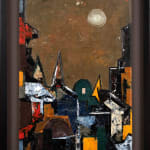Lancelot Ribeiro 1933-2010
Townscape, 1962
oil on canvas
59 x 42 cm
2022-18
© The Estate of Lancelot Ribeiro
Further images
Townscapes are a dominant motif of Ribeiro’s early work between 1958 and 1964, employing, as Katriana Hazell has observed, ‘distinctive images of spires, domes, towers, roofs and geometric blocks outlined...
Townscapes are a dominant motif of Ribeiro’s early work between 1958 and 1964, employing, as Katriana Hazell has observed, ‘distinctive images of spires, domes, towers, roofs and geometric blocks outlined in strong black strokes, often with a sun or moon or even multiple planets overhead’ (Restless Ribeiro: an Indian artist in Britain, p. 17), and always devoid of people. Their sharp-edged forms in jewel-like colours are reminiscent of both the stained glass that he would have observed in churches during his Catholic upbringing, and also of the technique of collage. Ribeiro explained that the landscapes were not of real, observed locations, but instead ‘a sort of collective experience’, that referenced the powerful impact of Christian imagery, as well as the influence of his half-brother, the painter F. N. Souza, in his early years. In a later series of pen and watercolour drawings of townscapes in the 1970s Ribeiro again explored this motif, employing a freer use of line and a strong sense of pattern.
Provenance
Presented by the Estate of Lancelot Ribeiro 2022Be the first to know – Sign Up
Subscribe to our newsletter and be the first to know about everything new at Ben Uri, including the constantly evolving and expansive online content across our exhibitions, collection and research.
We value and respect your privacy. Your personal data will be kept private and processed securely, according to our Privacy Policy. If you change your mind anytime, you can unsubscribe directly when receiving a mail from us (the link will be at the bottom of the email) or contact us.
* denotes required fields
This website uses cookies to improve your experience. If you are not happy with this, you can opt-out below.



